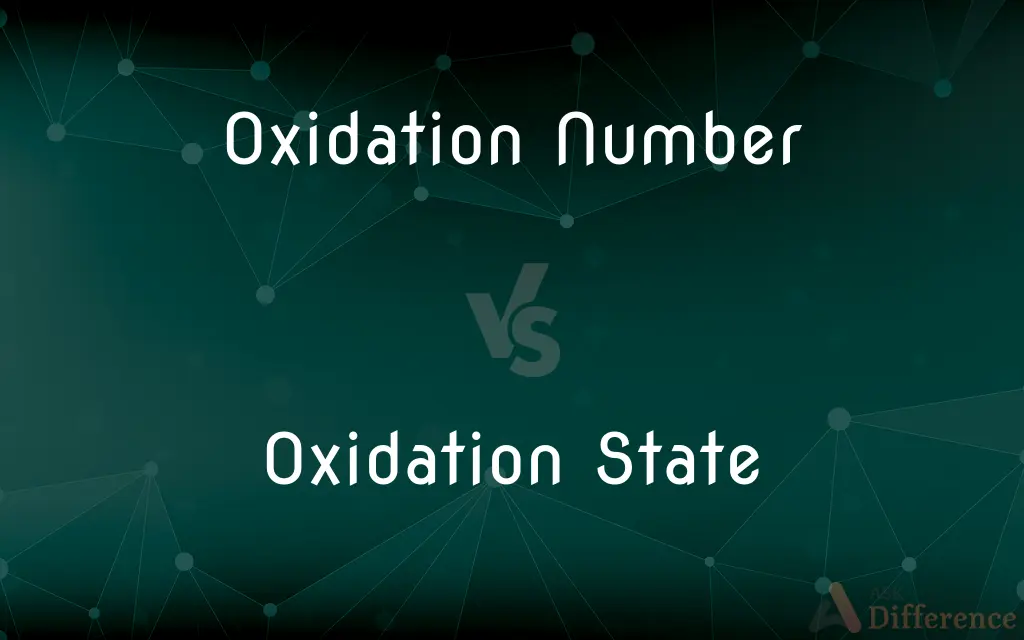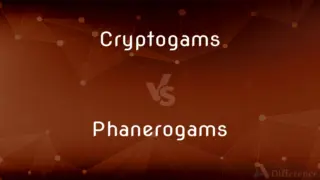Oxidation Number vs. Oxidation State — What's the Difference?
By Tayyaba Rehman — Published on December 27, 2023
Oxidation Number and Oxidation State refer to the degree of oxidation of an atom in a compound, with the terms often used interchangeably in modern chemistry.

Difference Between Oxidation Number and Oxidation State
Table of Contents
ADVERTISEMENT
Key Differences
Oxidation Number and Oxidation State are both concepts in chemistry that describe the degree of oxidation or reduction of an atom within a molecule or ion. They provide insight into the electron distribution in compounds.
Oxidation Number is traditionally defined as the charge that an atom would have if all shared electrons were assigned to the more electronegative atom. On the other hand, Oxidation State can be seen as a measure or representation of the degree of oxidation of an atom in a substance.
While both Oxidation Number and Oxidation State serve to indicate the effective charge on an atom, they originated from different conceptual viewpoints. However, the boundary between them has blurred over time, making their usage almost synonymous in modern chemistry.
In some older literature, distinctions between Oxidation Number and Oxidation State might be more pronounced, but in contemporary texts and research, the distinction is often negligible. Both terms help predict and explain reactivity, bonding, and the color of substances.
It's crucial for students and professionals to be aware that both Oxidation Number and Oxidation State offer a simplified view of electron distribution and don't always represent the true electronic structure of compounds. Nevertheless, they remain valuable tools in understanding chemical behavior.
ADVERTISEMENT
Comparison Chart
Definition
Hypothetical charge of an atom
Degree of oxidation of an atom
Origin
Based on electronegativity differences
Represents oxidation or reduction degree
Modern Usage
Often used interchangeably with Oxidation State
Commonly overlaps with Oxidation Number
Conceptual Foundation
More rooted in ion-like behavior of atoms
More generalized concept of oxidation
Role
Predicts electron distribution in bonds
Indicates overall oxidation level in chemical reactions
Compare with Definitions
Oxidation Number
Oxidation Number is based on the electronegativity difference.
Fluorine always has an oxidation number of -1 due to its high electronegativity.
Oxidation State
Oxidation State can predict possible chemical transformations.
Knowing the oxidation state of a metal can guide synthesis routes in inorganic chemistry.
Oxidation Number
Oxidation Number denotes the electron distribution in bonds.
In HCl, hydrogen has an oxidation number of +1.
Oxidation State
Oxidation State provides insight into reactivity.
Elements in higher oxidation states are typically more reactive.
Oxidation Number
Oxidation Number helps in balancing redox reactions.
Determining the oxidation number of elements in a reaction aids in redox balancing.
Oxidation State
Oxidation State is often used synonymously with oxidation number.
In many textbooks, the terms oxidation state and oxidation number are used interchangeably.
Oxidation Number
Oxidation Number is a hypothetical charge of an atom.
The oxidation number of oxygen in H₂O is -2.
Oxidation State
Oxidation State indicates the degree of oxidation of an atom.
The oxidation state of iron in Fe₂O₃ is +3.
Oxidation Number
Oxidation Number can be positive, negative, or zero.
In elemental nitrogen (N₂), the oxidation number is 0.
Oxidation State
Oxidation State can vary in different compounds.
Sulfur has an oxidation state of -2 in H₂S and +6 in SO₄²⁻.
Common Curiosities
What do Oxidation Number and Oxidation State represent?
They both indicate the degree of oxidation or reduction of an atom in a compound.
How is the Oxidation Number determined?
It's assigned based on electronegativity differences and electron distribution in bonds.
Are Oxidation Number and Oxidation State the same?
In modern chemistry, they are often used interchangeably, though they originated from different concepts.
Which term is more commonly used in modern chemistry?
Both are commonly used, but the choice often depends on context and preference.
Can Oxidation State be a fractional number?
In some cases, yes, especially when averaged over multiple atoms in a compound.
Can the Oxidation Number be used to balance redox reactions?
Yes, they are instrumental in balancing redox reactions.
How are Oxidation Number and Oxidation State used in inorganic chemistry?
They help understand the behavior of metals, coordination compounds, and reactivity patterns.
Is there a connection between Oxidation State and the periodic table?
Yes, elements in the same group often have similar common oxidation states.
Do all elements have an Oxidation Number or Oxidation State?
Yes, in compounds or ions they do. In their elemental form, it's zero.
Does the term Oxidation State only apply to oxidation reactions?
No, it's a general term that can apply to both oxidation and reduction processes.
Can an element have multiple Oxidation States?
Yes, many elements exhibit multiple oxidation states, especially transition metals.
Why are these terms important in chemistry?
They help in understanding electron distribution, reactivity, and bonding in compounds.
Is the highest Oxidation State always the most reactive?
Generally, higher oxidation states tend to be more reactive, but there are exceptions.
Are there any exceptions to typical Oxidation Number assignments?
Yes, there are exceptions based on specific bonding and molecular structures.
In which types of compounds is determining the Oxidation Number most crucial?
In complex compounds, especially those involving transition metals, determining oxidation numbers can be essential for understanding reactivity and structure.
Share Your Discovery

Previous Comparison
Article Writing vs. Report Writing
Next Comparison
Cryptogams vs. PhanerogamsAuthor Spotlight
Written by
Tayyaba RehmanTayyaba Rehman is a distinguished writer, currently serving as a primary contributor to askdifference.com. As a researcher in semantics and etymology, Tayyaba's passion for the complexity of languages and their distinctions has found a perfect home on the platform. Tayyaba delves into the intricacies of language, distinguishing between commonly confused words and phrases, thereby providing clarity for readers worldwide.











































